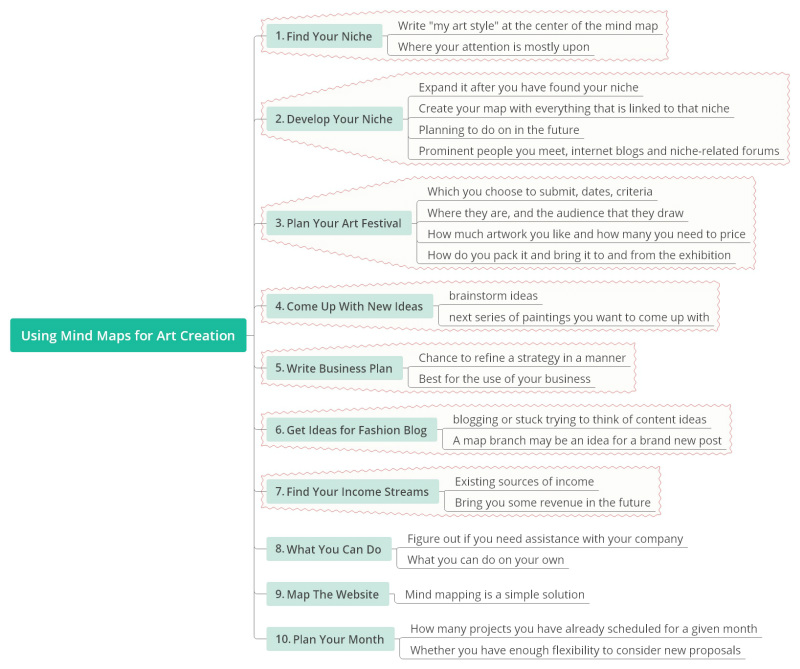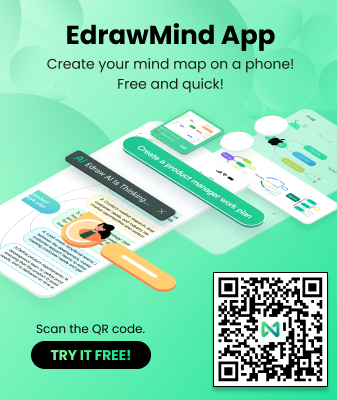How To Use Mind Map for Art Creation

Mind maps refer to a diagram with a branch or root-like structure that radiates from a page's central image, using lines and color to display the associations, groupings, and links between terms, concepts, and pictures. A mind map art lets students think logically, which offers space for various options, promoting thought beyond the box.
A mind map art is a diagram that starts in the middle of a blank page, where you write a keyword or sentence. You will create branches and sub-branches from this core "concept" to compose related phrases, concepts, and even pictures that contribute to the principal idea.
Since the brain typically does not think in list form, but spontaneously, the shape of this tree-like structure will assist your imagination and act as a dumping ground during the mind map process.
A mind map is a fantastic graphic aid which can help:
- Clarify your ideas;
- Identify your goals;
- Ignite your creativity;
- Revitalize your purpose;
- Rejuvenate your zest for life.
Elements considered when creating mind maps for art
- Concept - What's my idea? What should I be exploring?
- Influences - Who / What will be my inspiration?
- Techniques – How do I get to explore my idea?
- Developing designs - What is a sample body? What factors do I need to employ?
- Contexts – What results can my idea produce?
- Evaluation - What are my criteria to evaluate my success?
- The result – Where do I expect that to lead?

Source: Pinterest
- Think about the big idea and write it down in the center;
- Draw from the big ideas and write 3-4 big secondary ideas relevant to the big ideas. They should be connected, but they should be distinct and essential to count as a secondary branch;
- Draw 4-5 tertiary divisions from those 3-4 secondary branches and mark them with topics relevant to and represent those concepts;
- Your subjects will repeat-circle repeated topics and make a list of them for later use. You can even connect branches anywhere you like, and you don't have to fill up all extensions that you've drawn;
- Employ tertiary divisions of divisions. Label them with, and you can add more information.
There are 10 ways of using mind maps for art creation, from which you could explore more methods to create art.

Source: EdrawMind
- Find Your Niche
There is a simple way to find a niche. Write "my art style" at the center of the mind map and then build upon it. When your plan is done, you can see where your attention is mostly upon.
- Develop Your Niche
You want to discover ways to expand it after you have found your niche. Then create your map with everything that is linked to that niche. That could include things you've been working on and planning to do on in the future, networks you subscribe to that contribute to that niche, prominent people you meet, internet blogs and niche-related forums, etc.
- Plan Your Art Festival Season
There are a lot of things to consider when planning for art festivals. It shows to which you choose to submit, dates, criteria, where they are, and the audience that they draw. Then map which shows you need for each your setting, your tent, and your hanging device.
How much artwork you like and how many you need to price. How do you pack it and bring it to and from the exhibition? Procedures for the distribution and sale of products are certain things to keep in mind while mind mapping.
- Come Up With Ideas for Next Art Series
For individual artists, this is a great technique to brainstorm ideas as they can let their creativity flow. Think about the next series of paintings you want to come up with.
- Write Business Plan
Lots of business plans have been written about and how relevant they are for any form of company. It will be a chance to refine a strategy in a manner that is best for the use of your business, whether its freelancing or agency based.
- Get Ideas for Your Fashion Blog
If you've just begun your blogging or stuck trying to think of content ideas, why don't you try mind mapping those ideas? A map branch may be an idea for a brand new post or a whole set of seats.
- Find Your Income Streams
List all the places that are existing sources of income or could bring you some revenue in the future.
- Figure Out If You Need Assistance
You can visually see for all those tasks you don’t enjoy doing, so there are options to hire people who can do this job instead. Mind mapping can help you figure out potential pain points in your business.
- Map The Website
Are you being overwhelmed with all the choices, blogs, mega-sites on social media, and everything related to that? Mind mapping is a simple solution.
- Plan Your Month
This way, you know how many projects you have already scheduled for a given month, and whether you have enough flexibility to consider new proposals.
EdrawMind is a wonderful software that helps to create efficient and visually appealing mind maps.

Source: EdrawMind
- Amazing clipart collections - The built-in clip arts of EdrawMind covers in detail all related fields;
- Range of color options - EdrawMind can help you creatively design any mind map. It is super intuitive to ensure that your creative juices keep flowing;
- Huge mind map models - EdrawMind's primary contests are innovative prototype modeling and diversified formats. As with most common presentation modes, EdrawMind splits the entire mind map into many "slides."
A designer can quickly imagine how effective is the use of mind maps during their studies or in their career. While creating ideas is just one step of a design process, there is much more involved in the mind map, making it beneficial to use at all levels.
Contrary to many brainstorming methods, the concept of an idea is improved. A mind map helps us think about a problem holistically and tackle the problem on all sides. In contrast, most designers use more than one brainstorm method. Mind map art a very successful way of making these creative juices flow.
EdrawMind lets you organize ideas and create a framework of procedures that suit all your artistic needs.







